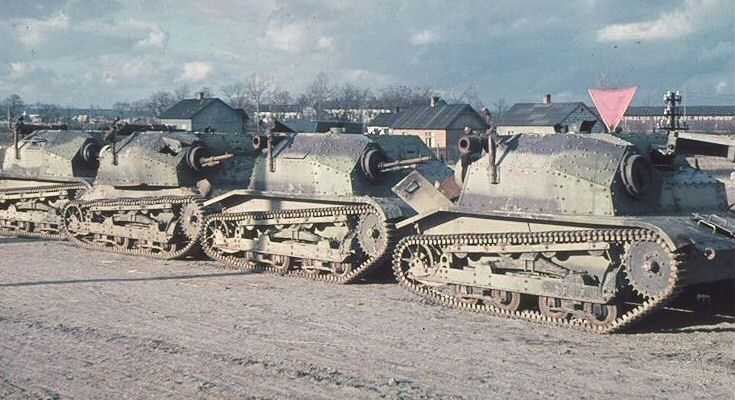This page contains description of the Polish tankettes TK (TK-3) and TKS (camouflage, armament, armour, technical description, specifications), list of survivors and a modelling section. For their development and production models - see Part I.
Camouflage
 |
| The TKS in the early camouflage, displayed in Estonia in 1934. |
Early camouflage
Between 1932 and 1936, the Polish armoured vehicles used an early camouflage scheme, commonly called: "the Japanese camouflage" in Poland. Its normative source has not been found in archives so far, therefore there are some doubts concerning the colours used. According to the newest research, basing on examination of museal items, it consisted of big irregular patches of yellowish sand, olive green and light blue-gray, separated
with thin black stripes; blue-gray being the lightest shade[7]. Traditional publications commonly quoted dark brown colour instead of blue-gray, and considered sand the lightest shade[1,3,10]. There was a standard pattern of patches initially (seen on TKS here), but many tanks featured different patterns or had some colours inverted[7]. The interior was blue-gray, inner surfaces of hatches were camouflaged[7].
Before an introduction of the "Japanese" camouflage, five "iron" TK-3 of the first series were experimentally painted in black and white patches, five in blue-gray overall and five in yellow and green patches [10].
 |  |
| TK-3 tankettes in the early camouflage, with tactical signs (left - the 2nd platoon's commander, right - the 1st platoon's tankette). |
 | 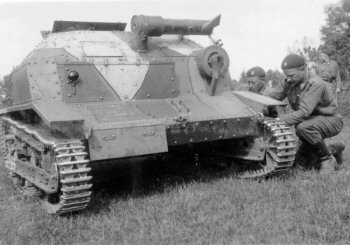 |
| TKS tankettes in the early camouflage (left: tested in Estonia - note camouflaged hatches). |
 |
| Late production TKS in the new camouflage (late variant), funded by the workers of Ursus works in 1938. [AJ, 6] |
Late camouflage
From 1936 on there was a new standard three-colour camouflage scheme introduced for all the Polish military vehicles. It consisted of irregular patches of greyish sand and
dark brown (sepia) airbrushed over a base color of olive-green. The patches had soft transitions, their shapes were mainly horizontal, often close to rectangular or rhomboid. There was not any standard pattern of patches, although the patterns used were similar (the instruction gave example views of front and right side of the TKS only). Often the patches created a kind of a chessboard, especially on late series vehicles. Transitions between colours are often inconspicuous on black and white photos. An interior was painted sand, including hatches.
Almost all tankettes were repainted in the new camoflage in the late 1930s, only some of tankettes used as armoured draisines of armoured trains and possibly some training vehicles remained in the old camouflage in September 1939 (like this TKS from an armoured train, captured by the Germans).
 |  |
| Left: TK-3 in the early camouflage. Right: a cannon-armed TKS in the final standard camouflage. Copyright © Thierry Vallet - Kameleon Profils - courtesy by Thierry Vallet. |
 |  |
| Drawings of TKS and a cannon-armed TKS in the standard camouflage. A camouflage layout on the TKS (left) is based upon the instruction. Copyright © Thierry Vallet - Kameleon Profils - courtesy by Thierry Vallet. |
 |  |
| Examples of TK-3 and TKS in the standard camouflage, author Adam Jońca [3]. Note, that these drawings are quite old, and may not represent a layout of patches accurately. |
Markings
 |
| Three TKS in an early camouflage during exercises, with tactical signs of the 1st platoon. From the left: the platoon commander, the 2nd in command and a platoon's tank. [AJ] |
From the early 1930s until 1939, the Polish armoured vehicles carried no nationality signs in any form. Before the war, there were used tactical signs of metal sheet attached for training purpose - discs (the 1st platoon), triangles (the 2nd) or squares (the 3rd). The signs were white with a vertical red stripe for a platoon commander, or with a small red disc, triangle or square inside for the 2nd in command. Squadron commanders had a sign of a triangle in a circle in a square (example). Their colors could also be inverted.
In September 1939, the tankettes generally carried no insignia at all. Usage of any insignia was forbiden in case of war by the regulation from 1938, nonetheless there are several photos known of tankettes captured in September 1939, still carrying tactical signs. The photos from 1939 also show a few cases of unofficial unit and possibly individual insignia painted on tankettes (Pomerania's Griffon for TK-3s of the 81st Armoured Unit, arrows for TK-3 of an unknown unit, rocking horse - possibly on a tank of the 10th Cavalry Brigade, and one photo of a sword-armed hand on TK-3). Four-digit registration numbers were painted on front plates only until 1936, then registration plates with new numbers were carried inside.
See a gallery of a museal TKS in a camouflage according to the 1937 manual.
 |  |
The German-captured TK-3 tanketes in 1939. Left: a symbolic comparison of the tankette with the German tanks PzKpfw-IV and PzKpfw-II. It carries a sign of the 2nd in command of the 3rd platoon, of an unknown unit (note, that squadrons and companies in 1939 were two-platoon).
On the right, unique color photo of the TK-3 by Hugo Jaeger. The tankette carries a mysterious sign of a hand armed with a sword. |
 |  |  |
| German-captured TK-3 tanketes in 1939, with evident standard camouflage and an arrow insignia, of an unknown unit. |
Description:
Armament
 |
| The TKS in an early camouflage (non-standard patches) with the wz.25 machine gun on an anti-aircraft pivot, shown to Estonian officers in 1934. The tankette is from the early series (with four-part commander's hatch without an observation periscope). Note MG telescopic sight and leather straps on hatches. [AJ] |
Serial TK and TKS tankettes were armed with one 7.92mm Hotchkiss wz.25 machine gun, mounted in a front plate, before a commander/gunner. It was a standard machine gun of the Polish armoured vehicles.
In the TK, the machine gun was mounted on a pivot behind a drum armoured cover, which was turning horizontally with a weapon. Horizontal angle of fire was 40°. Vertical angle of fire was 50°, after opening gunner's observation hatch with an upper cover of the machine gun. The machine gun had standard open sights only. Ammunition was 1800 rounds, in 120-round belts (in 15 cases).
In the TKS, the machine gun was mounted in an universal ball mounting, with telescopic sights. Horizontal angle of fire was 48°, vertical angle of fire was -15 +20°. Ammunition was 1920 rounds, in 120-round belts (in 16 cases, one case being attached to the machine gun).
About 20-24 tankettes TKS were rearmed with 20mm automatic cannon wz. 38 model A (FK-A) (read more in tankettes with 20mm cannon).
On both sides of the TK superstructure, and right side of the TKS superstructure, there was a pivot anti-aircraft mount for the wz.25 MG. It could be used only from the outside of a parked vehicle, after dismounting a weapon from the inside. There is no information if it found any practical usage. TK-3 tankettes fitted with radio, used as armoured draisines, had this pivot only on the left side, moved to the rear corner plate. Apart from the gun, 2.5 kg of explosives were carried.
Armour
Armour of rolled plates, thickness: (thicker plates were vertical)[1]
| Front | sides | rear | top | bottom |
| TK-3: | 6 - 8 mm | 8 mm | 6 - 8 mm | 3 - 4 mm | 4 - 7 mm |
| TKS: | 6 - 10 mm | 5 - 8 mm | 5 - 8 mm | 3 - 6 mm | 4 mm |
| TKS late: | 8 - 10 mm | 8 - 10 mm | 8 - 10 mm | 3 - 6 mm | 5 mm |
 |  |
| Armour thickness of a basic production TKS (base drawing: [8], data: [6]). |
Construction:
 |
 |
| Front view of the TK (left) and the TKS (right). [1] |
 |
 |
| Rear view of the TK (left) and the TKS (right). Note a towing hook with springs and a tactical sign on the TK. [1] |
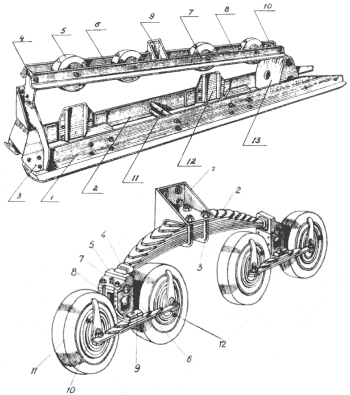 |
| Main units of the TKS suspension: the suspension frame and bogies with the main semi-elliptical leaf spring, from a manual [1,6,8]. The TK-3 suspension was very similar. |
 |
| An original cross-section of the TK3 [1,10] |
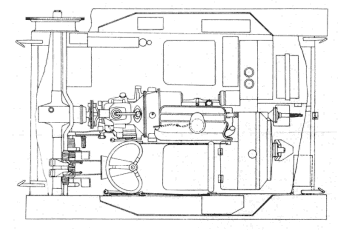 |
| Up and below: an original cross-section of the TKS, from a manual [8]. See drawings with descriptions |
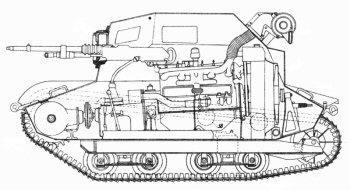 |
Chassis: on each side of the vehicle there were four road wheels, rubber rimmed, blocked in two two-wheel bogies, sprung with a pair of semi-elliptical leaf springs in each bogie. Bogies were moving up and down in runners of a suspension frame, and were sprung with a main semi-elliptical leaf spring, fixed centrally to the hull side (it was the main improvement over the Carden-Loyd suspension). A sprocket wheel was in front. At the rear there was an idler wheel, mounted on a suspension frame, with a tension adjustment mechanism. On each side there were 4 return rollers, mounted on an upper frame. The suspension of TK and TKS was similar, but differed in details, mainly in mounting of the idler wheel and a shape of a front frame connector (no. 3 on a drawing on the right).
Tracks: metal, single-pin: TK-3 - width 140 mm, pitch 45 mm, TKF and TKS - width 170 mm, pitch 45 mm (?), average length 124-125 links.
Hull was of armour plates, screwed to a frame. A major part of the hull was taken by a common combat compartment, containing also an engine and transmission. A driver's seat was on the left, a commander/gunner's seat on the right. The seats were separated with the engine and a gearbox before it. In front part of the hull there were drive gears with a differential mechanism, under two service hatches. Behind a driver there was a vertical water radiator with a fan behind it, under a rear housing. Behind a commander there was a fuel tank and, in a rear, a battery (under a right rear service hatch). A cooling air was drawn through a radiator from a crew compartment and, in need, from a small bottom hatch before the radiator (40x15 cm in TKS; this hatch was also used to operate mechanisms in case of usage as an armoured draisine). The air came out by a grill in a left rear service hatch. Under this hatch there was a shaft for emergency starting the engine by crank (the crank was carried in a battery compartment). The cooling air also came out by a mesh above the fan housing and, in need, by a small rectangular hatch in the rear bottom vertical plate (operated by the driver; the TKS had a wider hatch).
In the upper part of the superstructure, there were observation hatches around the vehicle (first series TK-3 had two observation hatches on each side, later series had one hatch one each side). On all the flat roof above the compartment there was a common, wide, four-part hatch (TK-3) or two individual hatches, four-part above a driver and three-part above a commander (TKS. The earliest series without a periscope had two four-part hatches). The hatches had pairs of leather straps attached underneath and above for handling.
In the TKS, the driver's front observation hatch had a vision slot with a periscope. In the TK-3 there were simple observation hatches without vision slots, the same for TKS side hatches (they could be raised leaving a slot). In the TKS, starting from the 54th tank, the commander had the Gundlach's reversible periscope(W) for all-round observation, some were retro-fitted with it later. Tankettes were not fitted with a radio, except for some tankettes used as armoured draisines (they had batteries in outside boxes, on front or rear fenders, and had a folding pole aerial on the right side). Signaling in a platoon was carried out by colour flags. The TK3 had 6V electric wiring, the TKS - 12V. The TK-3 had a single headlight on the left of the superstructure or a detachable searchlight, the TKS had a detachable searchlight only (usually not seen on photos). Both tankettes had a single red light at the rear, on the left.
Engine: petrol, inline, 4-stroke, water-cooled:
- TK-3: Ford A - 4-cylinder, 40 HP at 2200 rpm, capacity 3285 cm³
- TKS (first 82 serial tanks): Polski FIAT-122AC - 6-cylinder, 42 HP at 2600 rpm, capacity 2516 cm³
- TKS (from the 83th tank): Polski FIAT-122BC - 6-cylinder, 46 HP at 2600 rpm, capacity 2952 cm³
Transmission: multi-disc dry main clutch; mechanical gearbox - 3 (TK-3) or 4 (TKS) gears forward, 1 reverse (TK-3 had a reducer multiplying number of gears). Differential steering mechanism with band brakes; side drives. Turns were made by braking one track, using a steering wheel, connected with brakes. Fuel tank - 60l (TK3) or 69l (TKS)
 |
| A color cross-section of the TKS, by Janusz Magnuski [9] |
Specifications:
| TK-3 |
TKS |
|---|
| Crew | 2 |
2 |
| Empty weight |
2430 kg | 2570 kg (later series 2650 kg) |
| |
| Length |
2.58 m | 2.58 m |
| Width |
1.78 m | 1.78 m |
| Height |
1.32 m | 1.32 m |
| Ground clearance |
30 cm | 33 cm |
| Track width |
14 cm | 17 cm |
| Distance between track centres |
147.5 cm | 145 cm |
| Track length |
127 cm | 127 cm |
| |
| Max. speed on road |
46 km/h | 40 km/h |
| Road / off-road range |
200 / 100 km | 180 / 110 km |
| Obstacles: | | |
| Water depth |
50 cm | 50 cm |
| heights |
37° | 35° |
| trench width |
120 cm | 100 cm |
| Power to weight |
16.5 KM/t | 15 KM/t |
| Ground pressure |
0.56 kg/cm² | 0.43 kg/cm² |
| Turn radius |
240 cm | |
| Fuel consumption on road (off road) |
28 (60) l/100 km | 38 (70) l/100 km |
Survivors
From among tankettes captured by the enemies, several survived until now, more or less incomplete (for many years only two vehicles, in museums in Sweden and Yugoslavia, were known). None survived in Poland - only in the first decade of the 21st century three incomplete vehicles returned home from the abroad and were next reconstructed in Poland. Existing vehicles are:
- TK-3 - in a collection of Adam Rudnicki, Poland. A chassis acquired from France, with wholly reconstructed superstructure (2008). In a driving condition (non-original engine).
- TKF - in Kalemagdan Fortress museum in Belgrad, Serbia (often described as TK-3, lacks engine, interior equipment and identification plates) (a photo here)
- TKS - in the Polish Army Museum in Warsaw, Poland - a chassis with some upper plates was donated by the Pansarmuseet Axvall in Sweden in 2003 and restored by 2005 using parts found in the ground and some reconstructed ones. Originally it came from Norway. Recently (2008) it was restored to a driving condition. See its gallery.
- TKS - in a collection of Jacek Kopczyński, Poland. Revealed about 1999, when it was offered for sale by a private owner in Norway (photos here). It was left over by the Germans there and used as a tractor after the war with removed superstructure. Acquired by the current owner, who reconstructed part of armour. In a driving condition (non-original engine?).
- TKS nr. 1720 - in Kubinka armour museum, Russia (supposedly lacking interior equipment)
- TKS incomplete chassis - in Norway (private owner), nr. 1623, factory nr. 111.
Models
We will be grateful for supplementing information and comments on models.
1/72:
- -
Part (A004-72) - TK-3
- - Part (A005-72) - TKS
- - Part (A006-72) - TKW (prototype)
- Excellent high-tech kits of the Polish producer, made of photoetched brass with few resin supplements. No interior. Many small and subtle details, like recessed lines around observation hatches. See section "Modele - Kits" on Part's homepage (there are photos available under a camera icon)
- - First To Fight / Wrzesień 1939 (PL1939-001) - TKS w/ 20 mm gun
- - First To Fight / Wrzesień 1939 (PL1939-005) - TK-3
- - First To Fight / Wrzesień 1939 (PL1939-015) - TKS
- Newest (2013/2014) injection kits of Polish producer, issued as a periodical. Both TKS kits share the same hull, with different armament; TK-3 has own parts (and correct suspension). Quick build kits, but with outstanding detail level and correct dimensions. Tracks and suspension are one-piece. TKS with 20mm gun has some minor inaccuracies (shape of mantlet, details of the hull taken directly from TKS - remember not to glue AAMG mast!). Closed hatches, no interior. All in all, best injection kits of tankettes, that I have seen, and for low price.
- - ESO (7201) - TKS (with wz.25 MG or 20mm gun)
- Injection plastic kit of an ephemerical Polish producer - limited series, out of production. Highly detailed suspension and individual tracks, no interior, surface bolts modelled (quite big). Minor inaccuracies, like asymetrical machine gun housing and too small roof hatches (I don't know about overall dimensions accuracy). You can see a preview On The Way
- - RPM (72500) - TKS with wz.25 MG (original kit name "TK-S z 7,62mm km Hotchkiss wz.25" - obvious mistake as for caliber - it should be 7,92 mm)
- - RPM (72501) - TKS with 20 mm cannon
- - RPM (72502) - TK-3 (original kit name "TK-3 z 7,62mm km Hotchkiss wz.25" - obvious mistake as for caliber)
- - RPM (72503) - "Panzerkampfwagen TKS(p)" - TKS or TK-3 in the German service
- New Polish injection kits (2008), with many details (average quality ones, though) and interior. One-piece tracks, other piece suspension. Surface without bolts. I don't know overall dimensions accuracy. They all have one common set of sprues, with TKS chassis, and different sets of superstructure sprues, only set 72503 has all of them (the TKS chassis is incorrect for the TK-3, so it is TKF in fact, though it is hard to notice in a small scale). Rich sets of decals. Overally, economical and interesting offer - thanks to RPM for providing us with a mass-market model of most common Polish 1939 AFV at last. You can see them (and buy) here.
- - Modell Trans Modellbau (MT72009) - TK3
- - Modell Trans Modellbau (MT72021) - "TK-3 mit URSUS Autotransporter" - TK3 on the autotransporter
- Very good resin kits. One piece suspension and tracks, nice bolts. See a preview On The Way
- - NRC (7295) - TKS
- - NRC (7296) - TKS with 20mm gun
- - NRC (7297) - TKF
- - NRC (7298) - TK-3
- - NRC (72100) - TK with 20mm gun (prototype) (see a review On The Way)
- Simple resin models of the Polish producer NRC, fair quality and accuracy. One piece suspension and tracks. Possibly out of stock now?
- - Al.By (741) - "TKS 7.5mm MG" (wrong name - regular TKS with 7.92mm wz.25 MG)
- - Al.By (742) - "TKS .30 cal MG" (wrong name - the TKS prototype with a water-cooled 7.92mm wz.30 MG)
- - Al.By (743) - TKS 20mm Tankette
- Despite some minor inaccuracies (like gun mounting), these are nice-looking simple resin kits. One piece suspension and tracks. You can see preview On The Way.
- - FSF (WZ03) - TKS
- - FSF (WZ04) - TK-3
- Apparently crude and primitive resin models (FSF first releases...)
1/76:
- - BW Models (BP14) - TKS
- - Ostmodels (P1) - TKS
- - SHQ (PT-3) - "TKS small recon tank & trailer"
1/35:
-
- Mirage (35413) - TKS-B
- The Polish producer. The kit can be built as a regular TKS, TKS with 20 mm gun, or prototype TKS-B. Vinyl tracks, mediocre plastic quality, but good accuracy. No interior nor open hatches. (note, that the TKS-B with 20 mm gun was not existing variant).
- - Mirage (35515) - TKS/ MG 15 with trailer
- A tankette in the German auxiliary service - the same as above, with German AAMG and a French tracked trailer.
- - RPM
- RPM models are basing on the same few sprues. Some details, dimensions and proportions of TK and TKS are not accurate, and some models are fictious. However, all in all they are an economical offer. Good plastic quality, nice tracks (plastic or vinyl). Further comments below:
- - RPM (35005) - TKS prototype (wz.30 water-cooled MG)
- - RPM (35006) - TKS
- - RPM (35011) - TKS with 20mm FK wz.38 gun
- Three kits above use exactly the same set of sprues. Length and mounting of 20mm gun fits rather to 20mm Solothurn, tested in a prototype.
- - RPM (35004) - "PzKpfw TKS(p) /Ra 43"
- German artillery tractor variant, towing Ra 43 Püpchen. see a review here
- - RPM (35008) - "TK-SD"
- A prototype only, tested with 37mm SA-18 Puteaux gun. Beware! - not to confuse it with TKS-D (TK-SD) tank destroyer! It can be also built as regular TKS.
- - RPM (35010) - TK-3
- It has the chassis of TKS kit (differing from TK-3 chassis in some details), and some other details are not accurate.
- - RPM (35030) - Tankette interior set - an interesting kit of interior details for tankettes.
- - RPM (35031) - TKS with interior
- - RPM (35032) - TK-3 with interior
- The same models, as above, completed with an interior set.
- - RPM (35034) - "TKW-I" - (TKW, in fact)
- - RPM (35035) - "TKW-II"
- Models of a prototype light reconnaissance tank, with interior. Beware - TKW-II is a fictious version with 20mm gun!
- - RPM (35040) - TKD
- Experimental SP-gun with 47mm wz.25 "Pocisk" gun. Interesting model of experimantal SP-gun, with photoetched parts (still the same wrong TKS chassis, though) . You can see a review here
- - RPM (35042) - "CP - artillery tractor + 7,5cm Mk.97/38 gun"
- Fictious model of some alleged armoured "artillery tractor". The only real thing in this kit is 75mm wz.1897 field gun - Beware!
- - Note: early releases of RPM TKS and TKS 20mm differed from described above in some details, among others in not having the choice of weapons nor tracks.
- - Tom Modellbau (08) - TKS
- - Tom Modellbau (09) - TK-3
- The same, as RPM kits. Still wrong TKS chassis in case of TK-3 (see a preview here)
- - Fun Model - TKS
- Resin + metal kit, Polish producer.
- - Aber 35016 - TKS photoetched set for RPM / Mirage tankettes
- - Aber 35017 - TK-3 photoetched set for RPM / Mirage tankettes
- - IBG Models
- Newest and best injection kits of tankettes (2018), with additional PE parts. Tracks of separate links, apart from quick assembly kits with vinyl tracks.
- - IBG Models (35045) - TKS with wz. 25 MG
- - IBG Models (35046) - TKS with 20 mm gun
- - IBG Models (35047) - Panzerkampfwagen TKS (p) - German service, with wz. 25 MG (the same parts)
- - IBG Models (E3503) - TKS with 20 mm gun (quick assembly). Also kit E3501 with paints included.
- - IBG Models (E3504) - TKS with wz. 25 MG (quick assembly). Also kit E3501 with paints included.i.
1/48:
-
- CGD Elite Series - TKS
- New (2019) resin kit of TKS with 20 mm gun, with commander's bust. Poor accuracy.
Update history:
- 2020 - models updated
- 25. 8. 2009 - added survivors section, added photos, drawings and small improvements
- 29. 7. 2008 - improved, added modelling section
See other parts:
Part I: Development history & production
Part III: Service
Part IV: Tankettes with 20 mm cannons
Part V: Experimental tankettes & special equipment
Part VI: Foreign service
Self propelled guns
TKS gallery
Top of the page
Our Thanks to Adam Jońca.
Sources:
1. Janusz Magnuski, "Karaluchy przeciw panzerom"; Pelta; Warsaw 1995
2. Leszek Komuda, "Przeciwpancerne tankietki" in: "Militaria" Year 1 Nr. 3 and Nr. 4.
3. Adam Jońca, Rajmund Szubański, Jan Tarczyński, "Wrzesień 1939 - Pojazdy Wojska Polskiego - Barwa i broń"; WKL; Warsaw 1990.
6. "Czołg rozpoznawczy TK-S", Militaria i Fakty nr. 31 (6/2005)
7. "Czołg rozpoznawczy TK-S cz.2", Militaria i Fakty nr. 33 (2/2006)
8. "Opis i wskazówki obsługi czołga TK-S", PZInż. Biuro Studiów, 1935 (Army manual)
9. Janusz Magnuski, "Czołg rozpoznawczy TKS (TK)"; TBiU nr. 36; Wydawnictwo MON; Warsaw 1975
10. Zbigniew Lalak, "Czołg rozpoznawczy TK3 / Reconnaissance tank TK3" in Z. Lalak, T. Basarabowicz, R. Sawicki, M. Skotnicki, P. Żurkowski "Pojazdy II wojny światowej (tom 2) / Military Vehicles of WW2, part 2", Warsaw 2004, ISBN 8392036107
AJ - photos from a collection of Adam Jońca
[ Main page ] [ Polish armour ]
[ Polish armoured units ] [ Steel Panthers ] [ Links ] 
Comments or corrections are welcome.
All photos and pictures remain the property of their owners (some might be public domain). They are published in non-commercial educational and research purpose.
Text copyright to Michal Derela © 2007-2009.

